#rusty schweickart
Explore tagged Tumblr posts
Text

Apollo 9 astronaut Rusty Schweickart walks in space, March 6, 1969.
2K notes
·
View notes
Text

Astronaut Rusty Schweickart operates a camera during EVA, viewed from command module Gumdrop, Apollo 9
20 notes
·
View notes
Text

ESA (European Space Agency), space expo, Rusty Schweickart, NASA astronaut. Metal street slab with a hand print.
#ESA#European Space Agency#NASA#NASA astronaut#astronaut#astronauts#Rusty Schweickart#space#space expo#space travel#street slab#metal#hand print#photography#photo#photograph#picture#photos#photographs#image
6 notes
·
View notes
Text
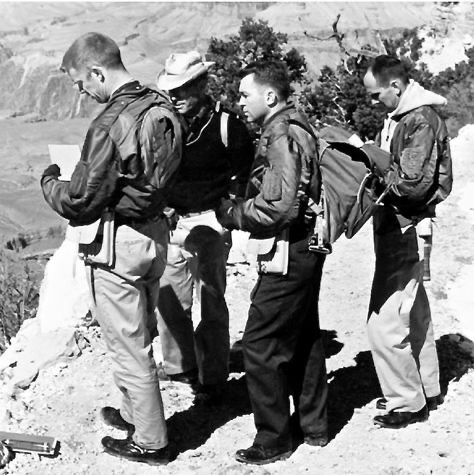
(Credit to the owner)
3 notes
·
View notes
Text
Trying to solve the problems makes the third LM so late to the Cape that there is not enough time to ready it for its scheduled flight.*
* That was why Apollo 8, originally intended to be a mission to Earth orbit using both the LM and the command module, became a command-module-only mission that went all the way to the Moon, and Rusty Schweickart and James McDivitt were the first to fly the LM on Apollo 9, an Earth-orbit shakedown cruise.
"The Moon: A History for the Future" - Oliver Morton
#book quotes#the moon#oliver morton#nonfiction#lunar module#problem solving#behind schedule#cape kennedy#running late#space flight#lunar mission#moon landing#apollo missions#apollo 8#orbit#rusty schweickart#james mcdivitt#apollo 9#command module
0 notes
Text

Stepping out on the front porch. Astronaut David Scott opens the hatch to check out the view during Apollo 9, March 1969. In this pic taken by fellow astronaut Rusty Schweickart, ‘Gumdrop’, the Command Service Module is docked with ‘Spider’, the Lunar Module. A9 was the 1st flight incorporating all Apollo spacecraft components. The 10 day mission was the 2nd launched by a Saturn V rocket.
#apollo 9#spacecraft#command module#low earth orbit#astronaut#space travel#1969#earth orbit#astronauts#space exploration#vintage space#space#space age#nasa#moon landing#space race#spaceflight#nasa astronauts#nasa photos#space history#spacesuits#1960s
411 notes
·
View notes
Text
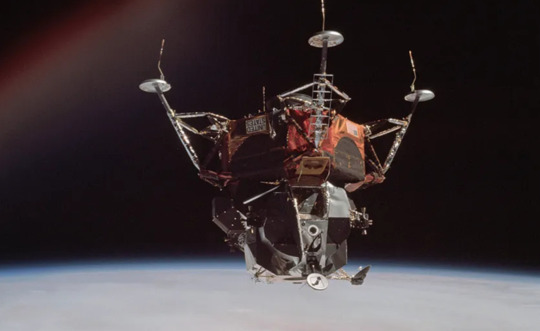
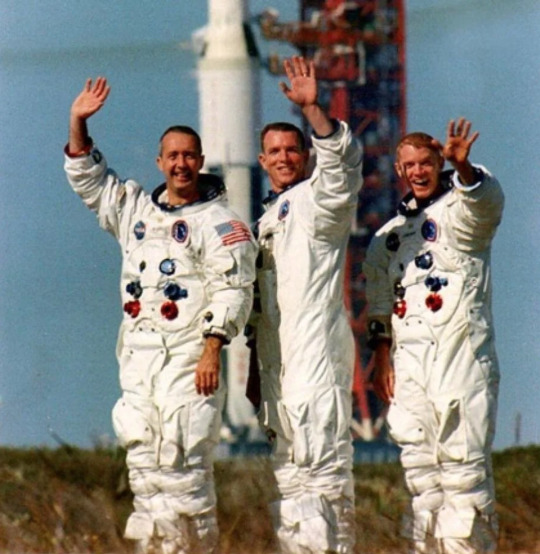
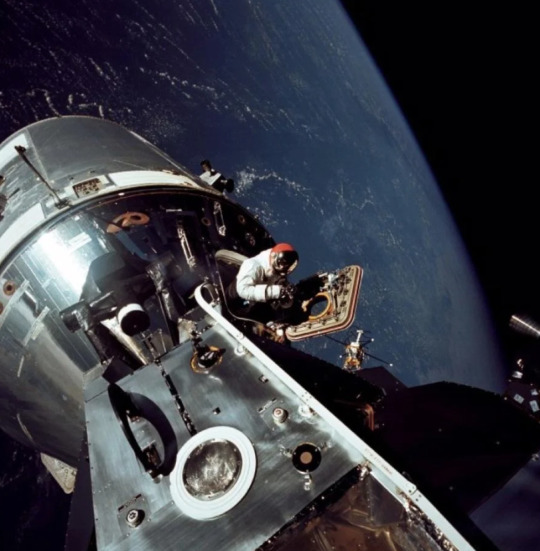

March 3, 1969 — Apollo 9 launches on the third manned Apollo mission
Apollo 9 was the final Earth orbital test of the Apollo spacecraft before landing on the moon and the first manned test of the Lunar Module in low Earth orbit. The mission brought back the old custom of naming spacecraft (Gumdrop for the CSM and Spider for the LM) and on mission day 4, Dave Scott and Rusty Schweickart performed the first two-man EVA in history.
Read more about Apollo 9 here!
46 notes
·
View notes
Text

1969, February 14… Apollo 9 press briefing At the Kennedy Space Center – Florida, Apollo 9 LMP Russell “Rusty” Schweickart briefed the press about the spacesuit for his upcoming spacewalk. For the very first time, Apollo 9 tested both the North American Aviation Command Module and the Grumman Lunar Module in Low Earth Orbit. Schweickart’s spacewalk would demonstrate an emergency transfer between both spacecraft. It was the last spacewalk before the Apollo 11 lunar-EVA in July 1969. Due to a construction delay at Grumman, the original Apollo 8 & 9 missions were swapped. By December 1968, Rusty Schweickart had completed vacuum testing the space suit portable life support chest- and backpack hardware in the altitude chamber of the Space Environment Simulation Laboratory at MSC Houston Texas. Note on the white Velcro strap the battered NASA-issued Omega Speedmaster 105.012 chronograph which was missing the lower push button. We know that some of the NASA-issued Speedmaster chronographs were solely used in astronaut training, n° 24 being the best-knwon example! (Photos: NASA)
#321#861#chronograph#Speedmaster#Moonwatch#Moonwatchuniverse#NASA#Apollo#astronaut#Omega#Omega Bienne#montres#uhren#pilot watch#spaceflight#spacesuit#military#Zulu time#Velcro
37 notes
·
View notes
Text
Cancelled Missions: Apollo AS-278

Planned launch: August 1967
Launch Vehicle: Saturn IB SA-207 and SA-208
Spacecraft: CSM-101 and LM-2
Prime crew:
-Commander: James Alton McDivitt
-Command Module Pilot: David Randolph Scott
-Lunar Module Pilot: Russell Louis "Rusty" Schweickart
Backup crew:
-Commander: Patten "Tom" Stafford CDR
-Command Module Pilot: John Watts Young
-Lunar Module Pilot: Eugene Andrew "Gene" Cernan
The mission number of AS-278, came from Saturn IB AS-207 and AS-208. It was also known as Apollo 3 and was planned as an D-type mission.

"It was planned that McDivitt's crew would conduct the Apollo D mission - a first manned test in earth orbit of the Lunar Module. Separate Saturn IB launches would put Apollo Block II CSM 101 / AS-207 and Lunar Module LM-2 / AS-208 into earth orbit a day later. The crew would then rendezvous and dock with the lunar module and put it through its paces.



When Schirra's Apollo 2 / AS-205 mission was cancelled in November 1966, the booster went to McDivitt's mission, and it was called AS-205/208, or AS-258."
-information from Astrnautix.com: link

Command Module 101 for Apollo-Saturn 205 mission on the workstand.
NASA ID: S68-42486

LM-2 under construction in Bethpage, Long Island, New York.
NASA ID: S68-36263
This flight was cancelled due of the Apollo 1 launch pad fire on January 27, 1967. After the fire, it was decided to launch the mission on a single Saturn V as Apollo 9. The prime crew remained the same for Apollo 9 but the backup crew flew as Apollo 10.
Information from spacefacts.de: link
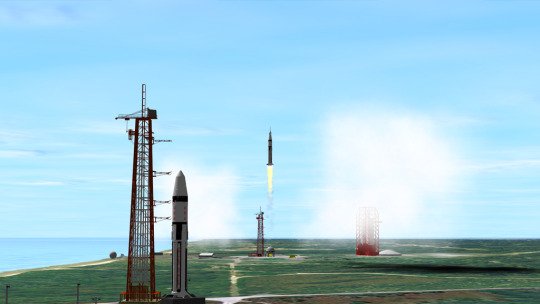
Launch of AS-205 (CSM-101/SA-205) from LC-34 while AS-208 (LM-2/SA-208) waiting on LC-37B to launch the next day
Screenshot from orbit-forum.com: link
source, source, source
#Apollo 3#AS-207#AS-208#AS-278#Apollo 2#AS-205#AS-258#Apollo CSM Block II#CSM-101#Lunar Module#LM-2#Saturn IB#SA-207#SA-208#SA-205#Rocket#NASA#Apollo Program#D-type Mission#Cancelled#Cancelled Mission#August#1967#my post
30 notes
·
View notes
Text

Apollo 9 astronauts Rusty Schweickart, Dave Scott and Jim McDivitt in front of their Saturn V Rocket. Their mission (March 3–13, 1969) was the third human spaceflight in the Apollo program. Unlike the missions before and after them, they did not leave Earth orbit and go to the moon. But it was important because it was the first test of a complete Apollo spacecraft (command and service module, lunar module and the Saturn rocket). During the mission, the crew tested the LEM and successfully performed a rendezvous and docking with the command module. The results of this mission proved the lunar module and landing craft were ready to go to the Moon on Apollo 10.
The excellent Tom Hanks/Ron Howard miniseries From the Earth to the Moon has a great episode that showcases Apollo 9 called "Spider" - the title comes from the nickname the astronauts gave the lunar lander. The show of course features the mission but does a superb job showing the numerous challenges the Grumman engineers had in designing, building and testing the lander.
41 notes
·
View notes
Text
Tbh the reason why I tend to refer to astronauts with like their nicknames is bc I’ve spent the last two and a half months obsessively learning about them and in a lot of their own words and their colleagues’ words they will be called by nicknames so I end up just picking it up but also like a lot of their nicknames were their preferred names anyway. Like Gus Grissom never went by Virgil he always went by Gus. His friends knew him as Gus. So he’s Gus. Rusty Schweickart goes by Rusty so I’m calling him Rusty. Buzz Aldrin’s real name is Edwin. No one on earth knows him as Edwin.
5 notes
·
View notes
Text
Space history...
Apollo 9 was a test mission in earth orbit of the spacecraft and equipment that would take NASA astronauts to the moon.
One of the activities planned was to rehearse transfer from the LM to the CSM via EVA, should it not be possible to use the tunnel between the two docked module. Here is how it was supposed to be done...

However, LM pilot Rusty Schweickart fell ill with space-adaptation syndrome and it was deemed too risky to attempt the transfer. Schweickart was cleared for an abbreviated EVA on the LM front porch in "golden slippers" foot restraints to test the Apollo EVA spacesuit and backpack.

Here, he's photographed by mission commander Jim McDivitt from inside the LM.
The scales etched into the LM window would be used on future missions to show the commander flying the LM where the computer intended to land.
2 notes
·
View notes
Text

Lunar module pilot Rusty Schweickart through lunar module window, Apollo 9
46 notes
·
View notes
Text
This actually reminds me of a scene from the HBO mini series From The Earth to the Moon, speaking of Astronausts.
Episode 5 (Spider). Jim McDivitt, Dave Scott, and Rusty Schweickart are talking about the upcoming Apollo 9 mission after some fishing.
Dave: "We're off the lake, Jim. Can we talk business now?
Jim: Well, if you insist.
Dave: I've been going over the mission plan, and it looks a little rough.
Rusty: It is kind of ambitious, Jim.
Jim: Heck, it's not ambitious. It's impossible! Look, everyone's focusing on us flying the LEM. It's only a small part of it.
Jim: Every mission's got a few things never been done before. This one's got about ten; First manned launch of a LEM, first docking extraction of a LEM, first men in a LEM in space. We just go out and fly the LEM, right? Wrong. Before we can even undock the LEM from the command module, we gotta make sure we can do an emergency transfer outside the spacecraft. Which means, Rusty, you're gonna have to do an EVA on the PLSS backpack, first use of that. Dave, we're gonna leave you alone in the command module. First time that'll happen. Then the real fun begins.
Jim: First, I pop the thrusters, see if the LEM can fly. If it can, Rusty and I fire the descent engine, take the thing on its maiden voyage. We go out 100 miles or so. God willing, the ascent engine lights, first firing of that in space. Then Rusty and I head back to you for the first docking of a two-man spacecraft.
Jim: So, it's only nine things that have never been done before. Come on. Give me a hand with the trailer, will ya?

9K notes
·
View notes
Text
International Asteroid Day - 30 June
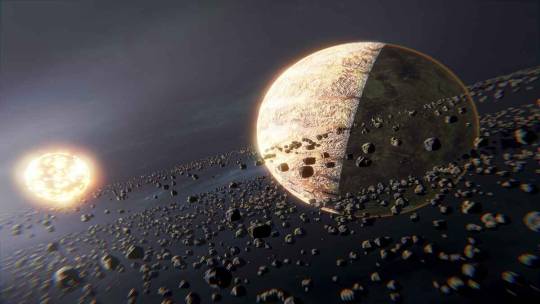
International Asteroid Day is celebrated every year on June 30th. It is an international campaign to raise awareness about asteroids. The marks the threat asteroids pose to Earth, and how to better protect our planet. This day brings together millions of people from all walks of life to recognize the danger that asteroids may bring. The day highlights the importance of ongoing research and development to protect the planet from asteroid strikes. The day is held in honor of the Tunguska explosion, which occurred on June 30, 1908. An asteroid entered Earth's atmosphere above Siberia and exploded. The incident leveled thousands of square miles of forest and killed hundreds of animals. Since then, understanding the dangers of asteroid strikes has become paramount in the effort to protect Earth's inhabitants. On Asteroid Day the B612 Foundation and other organizations commit and coordinate to protect the world from asteroid impacts. Celebration Events The celebration includes live events, panels, interviews, and even special events dedicated to Asteroid Day. These include lectures by distinguished experts in the fields of asteroid science, engineering, and hazard mitigation efforts. The world joins forces to learn more about this serious threat to our planet. International Asteroid Day stands out as an important reminder of the need to prepare for any potential danger. There are many ways to celebrate the International Asteroid Day. These include public lectures, educational activities, and interactive displays. We can engage the public in an effort to make them aware of the potential hazard of asteroids. We should also create opportunities for experts to discuss ideas and collaborate on projects to further our understanding of asteroids. This could include working together on virtual reality simulations and launching satellites to monitor near-Earth objects. The other way is creating educational and research materials to share with the global public. By making International Asteroid Day an annual event, we can help break down the barriers to entry for space exploration. This can help inspire the next generation of thinkers and innovators. Let's make Asteroid Day a global celebration of exploration and inspire the world to take action! 1. History Asteroid Day has been a global celebration for many years. First proposed in 2014 by international space scientists, including Apollo 9 Astronaut Rusty Schweickart, it reminds the threat of asteroids. These cosmic objects are remnants of the Solar System's formation and offer a unique view of the universe's power. On Asteroid Day, people join together to explore and celebrate these ancient relics. Educational workshops, interactive games, and other events are held worldwide to share the awe-inspiring stories of our cosmic past. As technology advances, Global Asteroid Day will continue to unite the world in recognition of the universe's wonders. 2. Impact The potential impact of International Asteroid Day, a global celebration is surely commendable. In collaboration between the United Nations, European Space Agency, and the Planetary Society, this event educates the public on topics related to asteroids. The day also highlights their potential to impact Earth, and the space industry’s efforts to detect and study them. International Asteroid Day is an amazing opportunity to increase awareness about space exploration. The day creates an awareness of various ways in which asteroids can affect our lives. With the support of leading astronomers, engineers, scientists, philanthropists, and organizations, this event enlightens about discovery and exploration. In the words of Planetary Society CEO Bill Nye, “Asteroid Day is a global event that celebrates the role asteroids have played in the formation of our Solar System and the critical role they continue to play in the exploration of our universe.” This is a perfect opportunity to learn more about the universe. We need to stay informed about our universe’s natural resources, such as asteroids. The event has support from a variety of organizations, including the International Astronomical Union, NASA, and the Royal Astronomical Society. With such an impressive roster of supporters, International Asteroid Day looks like an impressive event. It has the potential to further our understanding and appreciation of the impact of asteroids on our universe. 3. Education Asteroid Day is quickly becoming a worldwide celebration of space exploration. Every June 30th, we observe the day to educate the public on the significance of understanding asteroids. Its mission is to build global recognition of the potential impact of asteroid strikes and the requirement for space exploration. With lectures, films, interactive activities, educational programs, and community events, it aims to encourage the world to learn about asteroids. Education is a big part of this mission. International Asteroid Day offers a range of activities and resources to engage and teach people of all ages. With the correct motivation, this day can become a global event. The day can unite people of all backgrounds to celebrate space exploration and the importance of conquering its unknowns. 4. Events Celebrate Asteroid Day on June 30th and join people from around the world in recognizing the importance of asteroid exploration. From conferences to art exhibitions, events will be held in cities across the globe, including those in asteroid belt regions. Speakers from NASA, ESA, and other space exploration organizations will present on the state of interplanetary exploration, with astronomers, planetary scientists, and space industry experts on hand to answer questions and share insights. This is a chance to discover more about asteroid exploration - both now and in the future. Come be part of history in the making! 5. Advantages Asteroid Day is gaining traction worldwide as a celebration of space exploration. With increased awareness and appreciation of asteroids, we can unlock the potential for a new era of space exploration, bringing immense benefits. From inviting the public to attend lectures, demonstrations, and hands-on activities for Asteroid Day, to inspiring a new generation of scientists, engineers, and entrepreneurs to explore beyond, the educational benefits are immense. Learning the basics of science to understand the complexities of our Solar System is just the beginning. Let's make Asteroid Day a global commemoration of exploration and ensure its legacy continues to bring a better understanding of the universe. 6. Challenges International Asteroid Day reminds us of the challenges we face in protecting our planet from the catastrophic effects of rogue asteroids. Estimates suggest more than one million asteroids travel near Earth, some close enough to cause atmospheric disturbances or damage. But, the odds of an asteroid strike are low. Ensuring the preparation for an emergency, Asteroid Day is the perfect time to make everyone aware of the latest asteroid safety tips. Let's make it a worldwide celebration of space exploration and a reminder that we're all in this together! 7. Initiatives Asteroid Day, taking place on June 30th is a worldwide celebration of exploration and education about asteroids - the most plentiful and possibly oldest objects in our Solar System. A passionate group of scientists, educators, and media makers have worked hard to make asteroid exploration a global priority. Initiatives are being taken to ensure the success of Asteroid Day worldwide, such as a Global Observatory Network to map asteroids in our Solar System, a Global Educator Network to train and educate the next generation of scientists, and a Global Media Network to spread the message and create a long-lasting impact. The goal is to make Asteroid Day a global celebration and ensure everyone understands the importance of asteroid exploration. Make Asteroid Day Global and join the celebration! 8. Participation Asteroids are often overlooked, yet Asteroid Day is here to change that. Every June 30th, people of all backgrounds come together to explore space and appreciate asteroids. Participation is open to all, from experienced scientists to students. You can join online conversations, host an event, or access resources from the website. Now's the time to plan how to celebrate! With Asteroid Day, everyone has the chance to make a meaningful contribution to space exploration. Let's come together to make this a global celebration of exploration. In Short International Asteroid Day is an annual global awareness campaign. It raises attention to the potential hazard of asteroid impacts and the need of conducting research to protect our planet from them. It is celebrated every year on June 30th, the anniversary of the Tunguska impact of 1908, a powerful airburst that leveled over 2,000 km2 of forest in Siberia, Russia. This event is a unique opportunity to engage the public in conversations about the risks posed by near-Earth objects, the technological and scientific advances needed to protect us, and the potential of asteroid mining for resources and space exploration. We must not forget that asteroids are a fact of life in our solar system and that it is our responsibility to protect our planet from them. International Asteroid Day is a reminder of the importance of the work researchers and engineers around the world do. They identify and track these objects, and provide the public with the necessary knowledge and support to reduce the risk of asteroid impacts. As a global community, we must continue to work together to ensure our safety and security from potential asteroid threats. Image by Freepik Read the full article
0 notes
Text
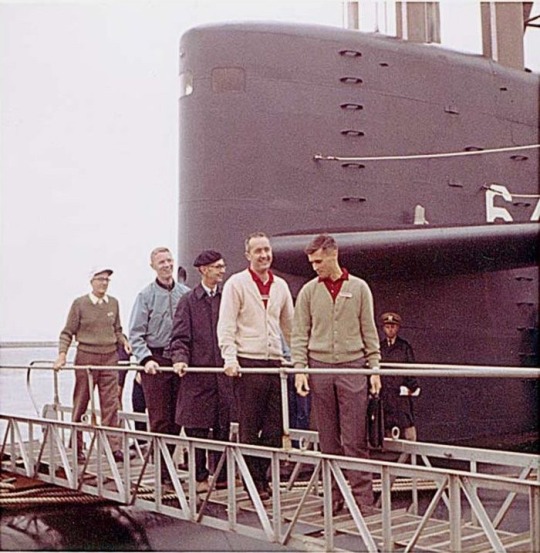
Roger, Jim and Rusty visting the USS Kamehameha at Cape Canaveral in early 1966.
21 notes
·
View notes